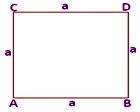Subscribe to our ▶️ YouTube channel 🔴 for the latest videos, updates, and tips.
Perimeter and Area of Square
The formula of perimeter and area of square are explained step-by-step with solved examples.
If 'a' denotes the side of the square, then, length of each side of a square is 'a' units
Perimeter of square = AB + BC + CD + DA
= (a + a + a + a) units
= 4a units
● Perimeter of the square = 4a units
We know that the area of the square is given by
Area = side × side
A = a × a sq. units
Therefore, A = a² square units
Therefore, a² = A Here, a is the side of the square.
Therefore, a² = √A
Therefore, side of the square = √Area
● Side of the square = P/4 units
● Area of the square = a × a = (P/4)² sq. units
● Area of square = 1/2 × (diagonal)² sq. units
● Length of the diagonal = √(a² + a²) = √(2a²^2) = a√2 units
Worked-out examples on Perimeter and Area of the Square:
1. Find the perimeter and area of a square of side 11 cm.
Solution:
We know that the perimeter of square = 4 × side
Side= 11 cm
Therefore, perimeter = 4 × 11 cm = 44 cm
Now, area of the square = (side × side) sq. units
= 11 × 11 cm²
= 121 cm²
2. The perimeter of a square is 52 m. Find the area of the square.
Solution:
Perimeter of square = 52 m
But perimeter of square = 4 × side
Therefore, 4 × side = 52 m
Therefore, side= 52/4 m = 13m
Now, the area of the square = (side × side)
Therefore, area of the square = 13 × 13 m² = 169 m².
3. The area of a square is 144 m². Find its perimeter.
Solution:
Area of square = side × side
Given; area of square = 144 m²
Therefore, side² = 144 m²
Therefore, side = √(144 m²) = √(2 × 2 × 2 × 2 × 3 × 3) m² = 2 × 2 × 3 m = 12 m
Now, the perimeter of the square = 4 x side = 4 × 12 m = 48 m
4. The length of the diagonal of a square is 12 cm. Find its area and perimeter.
Solution:
Diagonal of a square = 12 cm
Area of square = 1/2 (d)²
= 1/2 (12)²
= 1/2 × 12 × 12
= 72
Side of a square = √Area
= √72
= √(2 × 2 × 2 × 3 × 3)
= 2 × 3√2
= 6 × 1.41
= 8.46 cm
Perimeter of square = 4 × 8.46 = 33.84 cm
5. The perimeter of a square courtyard is 144 m. Find the cost of cementing it at the rate of $5 per m².
Solution:
Perimeter of square courtyard = 144 m
Therefore, side of the square courtyard = 144/4 = 36 m
Therefore, area of square courtyard = 36 × 36 m² = 1296 m²
For 1 m², the cost of cementing = $5
For 1296 m², the cost of cementing = $1296 × 5 = $6480
The above solved examples are explained how to solve perimeter and area of square with the detailed explanation.
● Mensuration
Perimeter and Area of Rectangle
Area and Perimeter of the Triangle
Area and Perimeter of the Parallelogram
Circumference and Area of Circle
Practice Test on Area and Perimeter of Rectangle
Practice Test on Area and Perimeter of Square
● Mensuration - Worksheets
Worksheet on Area and Perimeter of Rectangles
Worksheet on Area and Perimeter of Squares
Worksheet on Circumference and Area of Circle
Worksheet on Area and Perimeter of Triangle
7th Grade Math Problems
8th Grade Math Practice
From Perimeter and Area of Square to HOME PAGE
Didn't find what you were looking for? Or want to know more information about Math Only Math. Use this Google Search to find what you need.



New! Comments
Have your say about what you just read! Leave me a comment in the box below. Ask a Question or Answer a Question.